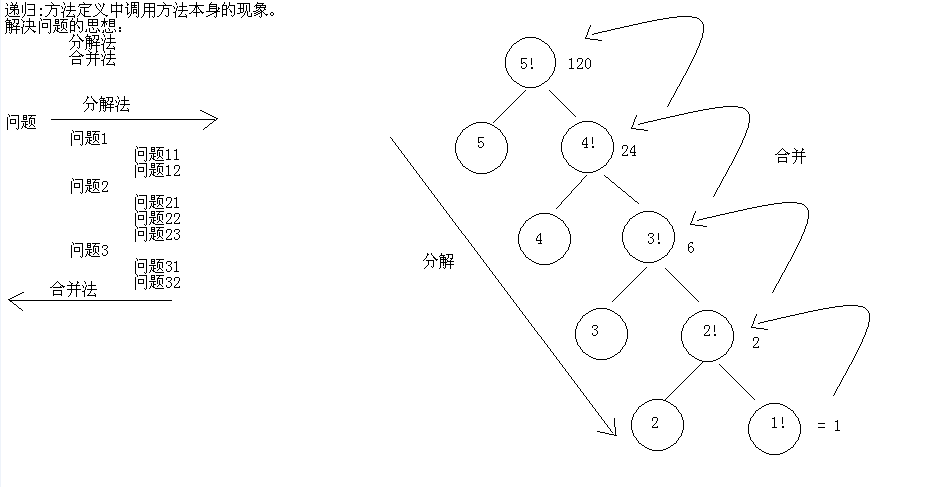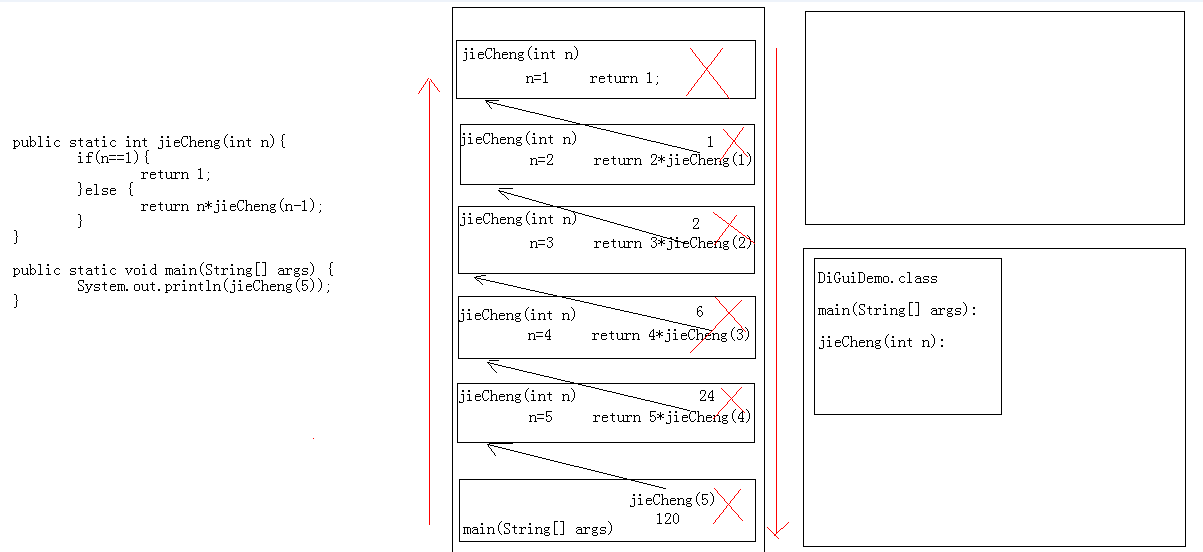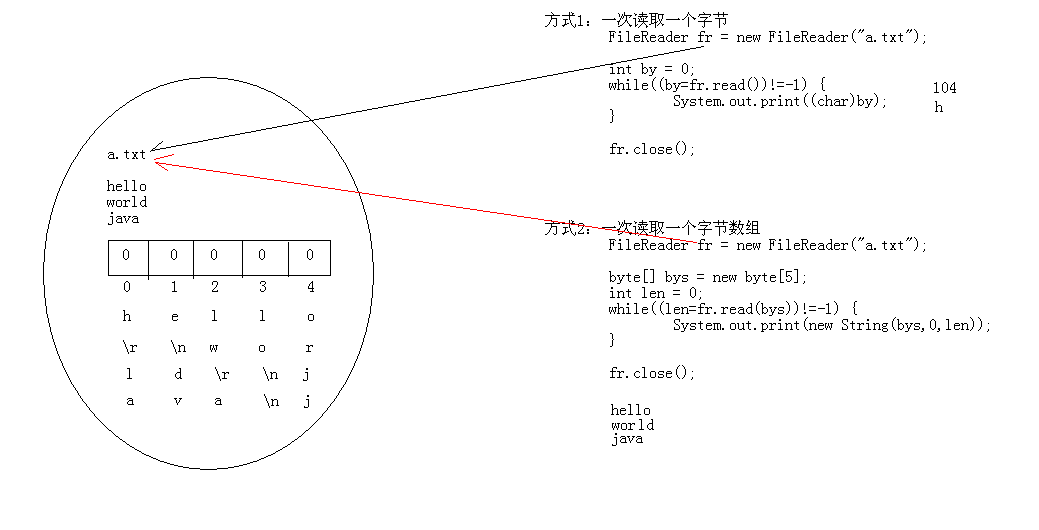1:递归(理解)
(1)方法定义中调用方法本身的现象举例:老和尚给小和尚讲故事,我们学编程
(2)递归的注意事项;
A:要有出口,否则就是死递归
B:次数不能过多,否则内存溢出
C:构造方法不能递归使用
(3)递归的案例:
递归思想分解法
A:递归求阶乘
/*
* 需求:请用代码实现求5的阶乘。
* 下面的知识要知道:
* 5! = 1*2*3*4*5
* 5! = 5*4!
*
* 有几种方案实现呢?
* A:循环实现
* B:递归实现
* a:做递归要写一个方法
* b:出口条件
* c:规律
*/
public class DiGuiDemo {
public static void main(String[] args) {
int jc = 1;
for (int x = 2; x <= 5; x++) {
jc *= x;
}
System.out.println("5的阶乘是:" + jc);
System.out.println("5的阶乘是:"+jieCheng(5));
}
/*
* 做递归要写一个方法:
* 返回值类型:int
* 参数列表:int n
* 出口条件:
* if(n == 1) {return 1;}
* 规律:
* if(n != 1) {return n*方法名(n-1);}
*/
public static int jieCheng(int n){
if(n==1){
return 1;
}else {
return n*jieCheng(n-1);
}
}
}
B:兔子问题
/*
* 有一对兔子,从出生后第3个月起每个月都生一对兔子,小兔子长到第三个月后每个月又生一对兔子,假如兔子都不死,问第二十个月的兔子对数为多少?
* 分析:我们要想办法找规律
* 兔子对数
* 第一个月: 1
* 第二个月: 1
* 第三个月: 2
* 第四个月: 3
* 第五个月: 5
* 第六个月: 8
* ...
*
* 由此可见兔子对象的数据是:
* 1,1,2,3,5,8...
* 规则:
* A:从第三项开始,每一项是前两项之和
* B:而且说明前两项是已知的
*
* 如何实现这个程序呢?
* A:数组实现
* B:变量的变化实现
* C:递归实现
*
* 假如相邻的两个月的兔子对数是a,b
* 第一个相邻的数据:a=1,b=1
* 第二个相邻的数据:a=1,b=2
* 第三个相邻的数据:a=2,b=3
* 第四个相邻的数据:a=3,b=5
* 看到了:下一次的a是以前的b,下一次是以前的a+b
*/
public class DiGuiDemo2 {
public static void main(String[] args) {
// 定义一个数组
int[] arr = new int[20];
arr[0] = 1;
arr[1] = 1;
// arr[2] = arr[0] + arr[1];
// arr[3] = arr[1] + arr[2];
// ...
for (int x = 2; x < arr.length; x++) {
arr[x] = arr[x - 2] + arr[x - 1];
}
System.out.println(arr[19]);// 6765
System.out.println("----------------");
int a = 1;
int b = 1;
for (int x = 0; x < 18; x++) {
// 临时变量存储上一次的a
int temp = a;
a = b;
b = temp + b;
}
System.out.println(b);
System.out.println("----------------");
System.out.println(fib(20));
}
/*
* 方法: 返回值类型:int 参数列表:int n 出口条件: 第一个月是1,第二个月是1 规律: 从第三个月开始,每一个月是前两个月之和
*/
public static int fib(int n) {
if (n == 1 || n == 2) {
return 1;
} else {
return fib(n - 1) + fib(n - 2);
}
}
}C:递归输出指定目录下所有指定后缀名的文件绝对路径
import java.io.File;
/*
* 需求:请大家把E:\JavaSE目录下所有的java结尾的文件的绝对路径给输出在控制台。
*
* 分析:
* A:封装目录
* B:获取该目录下所有的文件或者文件夹的File数组
* C:遍历该File数组,得到每一个File对象
* D:判断该File对象是否是文件夹
* 是:回到B
* 否:继续判断是否以.java结尾
* 是:就输出该文件的绝对路径
* 否:不搭理它
*/
public class FilePathDemo {
public static void main(String[] args) {
// 封装目录
File srcFolder = new File("E:\\JavaSE");
// 递归功能实现
getAllJavaFilePaths(srcFolder);
}
private static void getAllJavaFilePaths(File srcFolder) {
// 获取该目录下所有的文件或者文件夹的File数组
File[] fileArray = srcFolder.listFiles();
// 遍历该File数组,得到每一个File对象
for (File file : fileArray) {
// 判断该File对象是否是文件夹
if (file.isDirectory()) {
getAllJavaFilePaths(file);
} else {
// 继续判断是否以.java结尾
if (file.getName().endsWith(".java")) {
// 就输出该文件的绝对路径
System.out.println(file.getAbsolutePath());
}
}
}
}
}
D:递归删除带内容的目录(小心使用)
import java.io.File;
/*
* 需求:递归删除带内容的目录
*
* 目录我已经给定:demo
*
* 分析:
* A:封装目录
* B:获下的所有文件或者文件夹的File数组
* C:遍历该Fil取该目录e数组,得到每一个File对象
* D:判断该File对象是否是文件夹
* 是:回到B
* 否:就删除
*/
public class FileDeleteDemo {
public static void main(String[] args) {
// 封装目录
File srcFolder = new File("demo");
// 递归实现
deleteFolder(srcFolder);
}
private static void deleteFolder(File srcFolder) {
// 获取该目录下的所有文件或者文件夹的File数组
File[] fileArray = srcFolder.listFiles();
if (fileArray != null) {
// 遍历该File数组,得到每一个File对象
for (File file : fileArray) {
// 判断该File对象是否是文件夹
if (file.isDirectory()) {
deleteFolder(file);
} else {
System.out.println(file.getName() + "---" + file.delete());
}
}
System.out
.println(srcFolder.getName() + "---" + srcFolder.delete());
}
}
}
2:IO流(掌握)
(1)IO用于在设备间进行数据传输的操作
(2)分类:
(2)分类:
A:流向
输入流 读取数据
输出流 写出数据
B:数据类型
字节流
字节输入流
字节输出流
字符流
字符输入流
字符输出流
注意:
a:如果我们没有明确说明按照什么分,默认按照数据类型分。
b:除非文件用windows自带的记事本打开我们能够读懂,才采用字符流,否则建议使用字节流。
(3)FileOutputStream写出数据
A:操作步骤
a:创建字节输出流对象
b:调用write()方法
c:释放资源
B:代码体现:
FileOutputStream fos = new FileOutputStream("fos.txt");
fos.write("hello".getBytes());
fos.close();C:要注意的问题a:创建字节输出流对象做了几件事情?
* A:调用系统功能去创建文件
* B:创建fos对象
* C:把fos对象指向这个文件
b:为什么要close()?
* A:让流对象变成垃圾,这样就可以被垃圾回收器回收了
* B:通知系统去释放跟该文件相关的资源
c:如何实现数据的换行?
写入换行符号
*windows:\r\n
* linux:\n
* Mac:\r
d:如何实现数据的追加写入?
用构造方法带第二个参数是true的情况即可
输出流异常处理
import java.io.FileNotFoundException;
import java.io.FileOutputStream;
import java.io.IOException;
/*
* 加入异常处理的字节输出流操作
*/
public class FileOutputStreamDemo4 {
public static void main(String[] args) {
// 分开做异常处理
// FileOutputStream fos = null;
// try {
// fos = new FileOutputStream("fos4.txt");
// } catch (FileNotFoundException e) {
// e.printStackTrace();
// }
//
// try {
// fos.write("java".getBytes());
// } catch (IOException e) {
// e.printStackTrace();
// }
//
// try {
// fos.close();
// } catch (IOException e) {
// e.printStackTrace();
// }
// 一起做异常处理
// try {
// FileOutputStream fos = new FileOutputStream("fos4.txt");
// fos.write("java".getBytes());
// fos.close();
// } catch (FileNotFoundException e) {
// e.printStackTrace();
// } catch (IOException e) {
// e.printStackTrace();
// }
// 改进版
// 为了在finally里面能够看到该对象就必须定义到外面,为了访问不出问题,还必须给初始化值
FileOutputStream fos = null;
try {
// fos = new FileOutputStream("z:\\fos4.txt");
fos = new FileOutputStream("fos4.txt");
fos.write("java".getBytes());
} catch (FileNotFoundException e) {
e.printStackTrace();
} catch (IOException e) {
e.printStackTrace();
} finally {
// 如果fos不是null,才需要close()
if (fos != null) {
// 为了保证close()一定会执行,就放到这里了
try {
fos.close();
} catch (IOException e) {
e.printStackTrace();
}
}
}
}
}
(4)FileInputStream读取数据
A:操作步骤
a:创建字节输入流对象
b:调用read()方法
c:释放资源
B:代码体现:
FileInputStream fis = new FileInputStream("fos.txt");
//方式1
int by = 0;
while((by=fis.read())!=-1) {
System.out.print((char)by);
}
//方式2
byte[] bys = new byte[1024];
int len = 0;
while((len=fis.read(bys))!=-1) {
System.out.print(new String(bys,0,len));
}
fis.close();两种方式图解
A:复制文本文件
import java.io.FileInputStream;
import java.io.FileOutputStream;
import java.io.IOException;
/*
* 复制文本文件。
*
* 数据源:从哪里来
* a.txt -- 读取数据 -- FileInputStream
*
* 目的地:到哪里去
* b.txt -- 写数据 -- FileOutputStream
*
* java.io.FileNotFoundException: a.txt (系统找不到指定的文件。)
*
* 这一次复制中文没有出现任何问题,为什么呢?
* 上一次我们出现问题的原因在于我们每次获取到一个字节数据,就把该字节数据转换为了字符数据,然后输出到控制台。
* 而这一次呢?确实通过IO流读取数据,写到文本文件,你读取一个字节,我就写入一个字节,你没有做任何的转换。
* 它会自己做转换。
*/
public class CopyFileDemo {
public static void main(String[] args) throws IOException {
// 封装数据源
FileInputStream fis = new FileInputStream("a.txt");
// 封装目的地
FileOutputStream fos = new FileOutputStream("b.txt");
int by = 0;
while ((by = fis.read()) != -1) {
fos.write(by);
}
// 释放资源(先关谁都行)
fos.close();
fis.close();
}
}
B:复制图片
C:复制视频
(6)字节缓冲区流
A:BufferedOutputStream
BufferedInputStream bis = new BufferedInputStream(new FileInputStream("bos.txt"));
B:BufferedInputStream
BufferedOutputStream bos = new BufferedOutputStream(new FileOutputStream("bos.txt"));
A:复制文本文件
B:复制图片
C:复制视频
* 计算机是如何识别什么时候该把两个字节转换为一个中文呢?
* 在计算机中中文的存储分两个字节:
* 第一个字节肯定是负数。
* 第二个字节常见的是负数,可能有正数。但是没影响。
复制四种实现
import java.io.BufferedInputStream;
import java.io.BufferedOutputStream;
import java.io.FileInputStream;
import java.io.FileOutputStream;
import java.io.IOException;
/*
* 需求:把e:\\哥有老婆.mp4复制到当前项目目录下的copy.mp4中
*
* 字节流四种方式复制文件:
* 基本字节流一次读写一个字节: 共耗时:117235毫秒
* 基本字节流一次读写一个字节数组: 共耗时:156毫秒
* 高效字节流一次读写一个字节: 共耗时:1141毫秒
* 高效字节流一次读写一个字节数组: 共耗时:47毫秒
*/
public class CopyMp4Demo {
public static void main(String[] args) throws IOException {
long start = System.currentTimeMillis();
// method1("e:\\哥有老婆.mp4", "copy1.mp4");
// method2("e:\\哥有老婆.mp4", "copy2.mp4");
// method3("e:\\哥有老婆.mp4", "copy3.mp4");
method4("e:\\哥有老婆.mp4", "copy4.mp4");
long end = System.currentTimeMillis();
System.out.println("共耗时:" + (end - start) + "毫秒");
}
// 高效字节流一次读写一个字节数组:
public static void method4(String srcString, String destString)
throws IOException {
BufferedInputStream bis = new BufferedInputStream(new FileInputStream(
srcString));
BufferedOutputStream bos = new BufferedOutputStream(
new FileOutputStream(destString));
byte[] bys = new byte[1024];
int len = 0;
while ((len = bis.read(bys)) != -1) {
bos.write(bys, 0, len);
}
bos.close();
bis.close();
}
// 高效字节流一次读写一个字节:
public static void method3(String srcString, String destString)
throws IOException {
BufferedInputStream bis = new BufferedInputStream(new FileInputStream(
srcString));
BufferedOutputStream bos = new BufferedOutputStream(
new FileOutputStream(destString));
int by = 0;
while ((by = bis.read()) != -1) {
bos.write(by);
}
bos.close();
bis.close();
}
// 基本字节流一次读写一个字节数组
public static void method2(String srcString, String destString)
throws IOException {
FileInputStream fis = new FileInputStream(srcString);
FileOutputStream fos = new FileOutputStream(destString);
byte[] bys = new byte[1024];
int len = 0;
while ((len = fis.read(bys)) != -1) {
fos.write(bys, 0, len);
}
fos.close();
fis.close();
}
// 基本字节流一次读写一个字节
public static void method1(String srcString, String destString)
throws IOException {
FileInputStream fis = new FileInputStream(srcString);
FileOutputStream fos = new FileOutputStream(destString);
int by = 0;
while ((by = fis.read()) != -1) {
fos.write(by);
}
fos.close();
fis.close();
}
}
3:自学字符流
IO流分类
字节流:
InputStream
FileInputStream
BufferedInputStream
OutputStream
FileOutputStream
BufferedOutputStream
字符流:
Reader
FileReader
BufferedReader
Writer
FileWriter
BufferedWriter


























 1881
1881











 被折叠的 条评论
为什么被折叠?
被折叠的 条评论
为什么被折叠?








